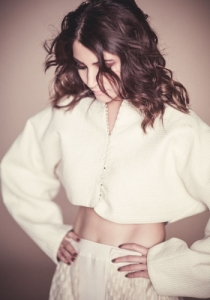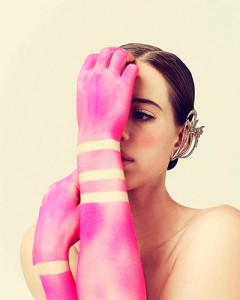Published: Verve Magazine, Cover Story, October 2016
Image credit: Tarun Vishwa

She’s waif-like, with fine features and aggressive sideburns. You would expect her to be loud and vivacious, but her off-camera persona is quietly dignified with moments of impetuousness. At Verve’s Best Dressed cover shoot, she inadvertently transforms breathtakingly into India’s answer to Audrey Hepburn. She’s poised and controlled, even though a stray, unstifled yawn delicately slips by between shots. Grievances, if any, are kept under wraps, evidenced only by the slight movement of the eyes which her very tuned-in press representative, Priyanka, catches. The blower gets switched off when the dress billows too much, her hand stays next to it, and she quietly strives for the perfect pose that keeps the skirt from doing a Marilyn Monroe while facing the lens with youthful zeal.
Unlike a tall, lissome model that you would want to make a clothes hanger, you nearly want to shoot Alia Bhatt with the bare minimum on, because she is, literally, comfortable in her own skin. And yet, she transforms in front of the spotlight with every kind of outfit that comes her way. Flirty dresses that lend romantic appeal, punk rock chic with attitude, jackets that demand attention and couture befitting an urban sophisticate. It’s all Alia, and you could keep going. Wielding props from metallic studded headphones to virginal blooms, she carries off the ready smiles and pouts like she was to the camera born.
It’s this chameleon-like adaptability to clothes, moods and the environment that makes her come alive on screen with a natural aura. She isn’t someone who needs the ‘right’ look or the ‘perfect’ environment to perform. Alia is a heady cocktail of daintiness amid sharpness: the limoncello that is quietly, unobtrusively intoxicating, without a harsh edge. And she has a wry sense of humour. It’s not slapstick and perhaps not sharp enough to be British, but it is blunt. When she can’t hear our creative director’s suggestions over the loud music, her lips curl into a slight smile to knock the bite off the words, “Either scream or don’t talk!”

The one ‘look’ that suggests longevity is the all-encompassing smile that radiates oomph and naïveté all at once: the glow of youth and the vigour of a woman. Alia Bhatt has an incredible fan following online, despite the live gaffes that have had the country in disbelieving splits. But then, refreshingly, like India rubber, she bounces back, laughing at herself, finding humour in the absurd and her fan base swells with overwhelming uproar. And that is style. The skill to be suave in situations that don’t appear favourable, to shrug those perfect shoulders and create your own brand of cool; that’s what makes Alia Bhatt stand out from the crowd. “I can’t answer questions about what others think about me or what image I am portraying. I prefer not to think about why I am not like the others. Then I will become conscious of it and I will try and be this fabricated version of myself which is not fun, and then you are taking yourself too seriously.”
She doesn’t need to be an intellectual, she’s smarter than that. Intellectuals alienate the masses, smart people know that being a nonchalant but authentic version of yourself is magnetic in a world of make-believe and press imagery. “You can’t develop that. You either have it or not. It’s actually not even an ability, it’s just who you are. I think a certain way, which I assume is how it’s supposed to be, and which reflects how I have been brought up. Because of the fact that people keep talking about it now, I feel that it’s a big deal to not take yourself too seriously.”
At 23, she is admittedly a dreamer, but in other words, she runs the happy risk of losing interest rapidly — and you have to work really hard to engage her. Much like a girl of her age, in today’s age. It’s a generation that perhaps isn’t heavy on wisdom, but is wise beyond their years. Wise enough to understand that in a world of ephemeral wants and multiple choices, it’s best to go with the flow. To know who you are and ignore naysayers and disbelievers. Because where’s the time for that? Alia Bhatt epitomises the young woman of today — self-assured but not self-reflective or conscious. “I know when people say things like ‘youth icon’ it bodes a sense of responsibility. I just hope that when they look up to anyone, or look at anyone, they see a real person they can connect with rather than the images portrayed on screen as characters.”
It’s important, to her, that this ‘real person’ be well-put-together. “If I am going out for an event, or a party, I always want to look impressive. And that’s not to impress one person in particular!” Who’s her definition of a best-dressed person? “Somebody who stands out without trying too hard; who can combine looks with a certain ease, which is not ‘black heels, a bodycon dress, tight and fitted right here, and perfect hair’. That’s nice, but there has to be some personality, something interesting about the way the person dresses. Either the combination, or the kind of clothes, keeping the trends in mind. Someone who basically understands their body, self and clothes.”
As spirited women from Indian cinema have often grappled with the question of publicity and image, Alia is very firm that being an actor of worth isn’t enough. “It is important to be well dressed. You can’t just be focusing on your talent. You have to be visually appealing. If you are beautiful, you would present yourself beautifully also.” Alia isn’t alien to making a good impression, in every way she can. Much like Angelina Jolie’s internet-breaking wedding gown decorated with the artwork of her children, Alia’s stylist came up with the idea of a ‘doodle dress’ during the promotion of her film Shandaar last year. “I feel really bad — we are constantly getting these lovely letters, drawings, paintings and pictures from our fans and we never get to do anything with them apart from looking at them and probably saving them. This way I can actually wear them, since clothes are such a big part of our lives. It was an ode to the fans.”
She’s recently bought adult colouring books, to rewind to a childhood passion. “It’s exciting, therapeutic and de-stressing; it’s complicated, but so much fun! And it’s still hard to stay inside the lines — which is important, to make it look neat and pretty.” And that defines Alia, striving to stay inside the lines, without toeing the line. Someone who always puts her best foot forward, even if she manages to put her foot in her mouth occasionally.

Alia Speak
“My trademark style is comfort mixed with fun and colour. I dress according to my mood — after all, I’m a Piscean! I’m always comfortable, no matter what I’m wearing.”
“I need my stylist(s) to push me. It’s also important that they understand my vibe. If I feel it’s not me, I won’t wear it even if it’s gorgeous. You need someone who understands fashion and trends, even making a look out of something in your own wardrobe. I may like a stand-alone top and a dress, but I may not be able to visualise a winning combination.”
“I love Kangana’s (Ranaut) sense of style. She has nailed the combination of being at ease and looking unique at the same time.”
“I would happily get into a ganjee and loose long overalls with jeans; pyjamas in bed; and sneakers over heels any day! I wear a nice dress if I’m dressing to impress. It can be a midi, but it should be interesting and not the short, typical outfit. I love what I wore for my birthday this year — the Bambah dress. There isn’t any look that I regret.”
“It takes me 20 minutes to get ready for a regular look and an hour for something dressier.”
“My go-to city for shopping is London.”
“I love ready-to-wear kind of brands like Chloe, Zadig & Voltaire and Anya Hindmarch. Locally, I love Manish (Malhotra), he’s an all-time favourite. From the newer lot, I really like Dhruv Kapoor.”
“I’m not a label-conscious person, I can wear anything from anywhere. But, I would choose bags from the luxury lines simply because I want them to be long-lasting and of high quality.”
“If I had to be a brand ambassador, I would choose affordable over luxury. For example, Anya (Hindmarch). The bags have a lot of personality.”
“I like following trends — because that’s what is available and looking good. I don’t follow every kind of trend…there are some which wouldn’t look good on me. I could never wear a fringe dress for instance — it would irritate me, the idea of everything just dangling about! Give me a fringe jacket, instead.”
“I have a love-hate relationship with food. While I love it, instinctively I don’t eat badly. I like it to be nutritious and I don’t enjoy the taste of junk grub any more.”
“I’ve recently turned vegetarian/pescatarian — I eat fish once in a blue moon. I went off meat — there is no religious reason, but I felt so much better when I was avoiding it. I prefer only three meals a day. I have porridge or granola (from the Paleo Foods Company) with almond milk for breakfast, sabzi-roti (ragi/jowar) for lunch and something light for dinner, like soup and an omelette, or fish and veggies. Or I have dahi-chawal. I love it, it’s my favourite thing to eat!”
“If I don’t work out, I get really cranky. I have always been like that. I was recently ill and forbidden to go to the gym and all I could think of was about when I could get back. I like sweating it out. I do a combination of Pilates and cardio. I also love swimming.”
“For a night out in town I go to my favourite restaurants for dinner. It’s generally with my sister (Shaheen) or my friends…I have three friends in total! I’d wear comfortable clothes, because if I go out, I eat!”
“I zone in and out of places, people and conversations like that (snaps fingers). I can dream about anything — what I want to do next, something that I saw, a movie that I want to see or be in, a vacation….”
“I have an obsessive-compulsive disorder — vis-à-vis my hands. I need to keep cleaning my hands. While running on the treadmill all I can think about is how I need to clean my hands! It’s very irritating — you reminded me of it now again. And then I keep smelling them. (Smells them.) Now I want some cream.”
“When not working, I just want to sleep…lie in bed and watch Downton Abbey or Friends. Comfortable, happy stuff.”



















